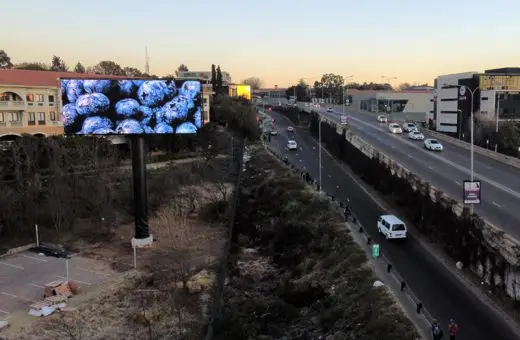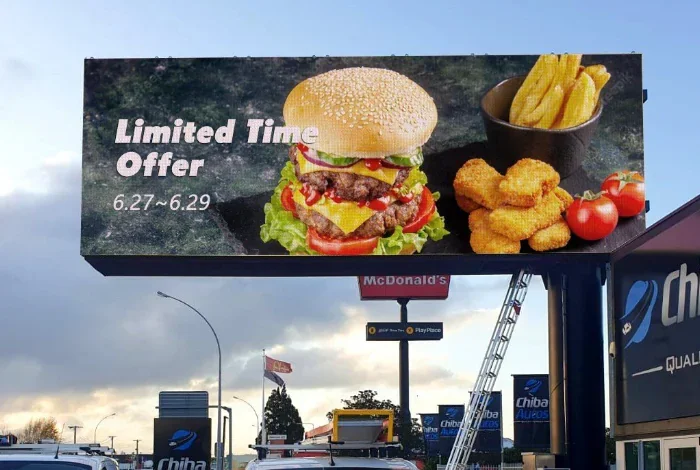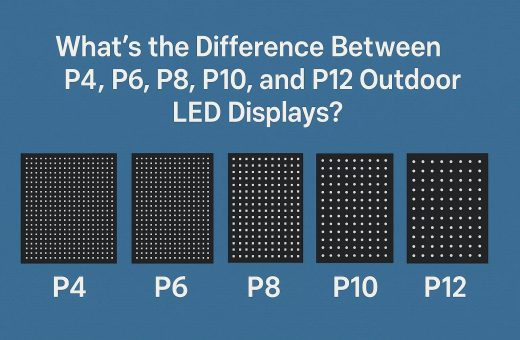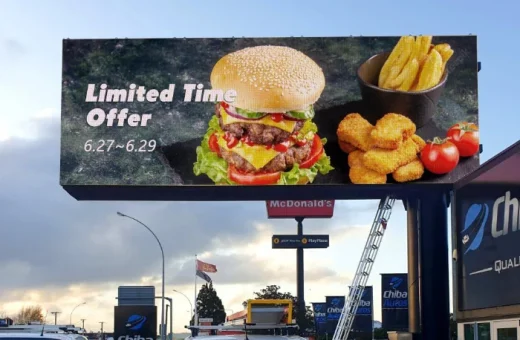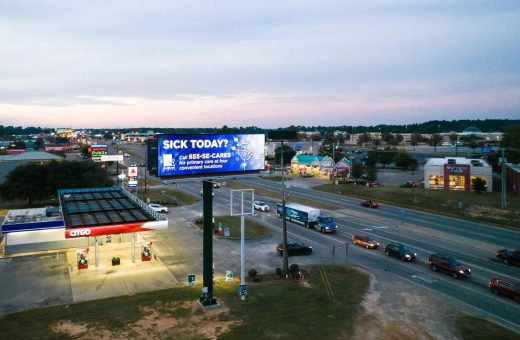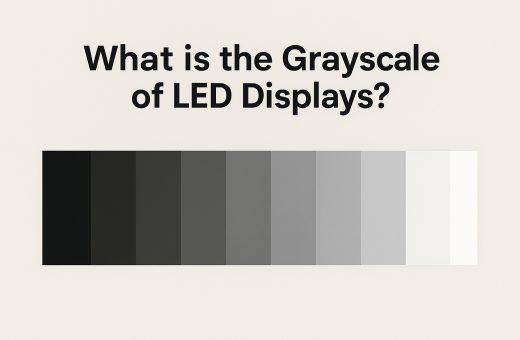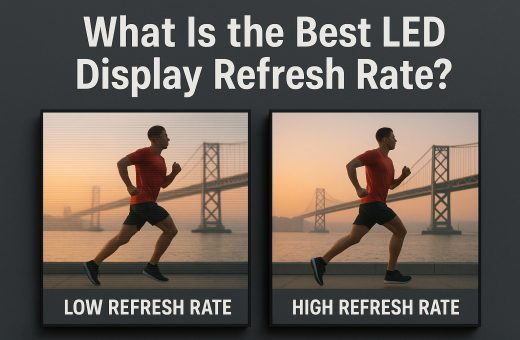Table of Contents
The pixel pitch for an LED display refers to the distance between the centers of two neighboring pixels. It plays a key role in determining image clarity, viewing comfort, and overall cost. A smaller pixel pitch delivers sharper visuals but normally comes at a higher price, making it essential to match the pitch with the actual viewing needs.
On this page, Chainzone will explain how LED display pixel pitch affects performance, helping you choose the most practical option for your project.
What Is Pixel Pitch?
Pixel pitch is the measurement, usually in millimeters, between the centers of two adjacent pixels on an LED display. This spacing directly affects content sharpness at different viewing distances.
A smaller LED display pixel pitch indicates the pixels are packed closely, thus enabling finer image detail and better clarity up close. Conversely, larger pixel pitches are suitable for situations where the audience views the screen from farther away, such as roadside billboards or stadium displays.
How to Choose the Right Pixel Pitch: Key Factors
Here are some key factors that should guide your decision to select the right LED display pixel pitch:
1. Viewing Distance
Viewing distance is the most influential factor in determining the appropriate pixel pitch. Two widely accepted guidelines can help:
- The 1000× Rule: Multiply the pixel pitch (in millimeters) by 10 to estimate the ideal viewing distance in feet. For example, a 2 mm pixel pitch is best viewed from approximately 2 meters away. This ensures content appears smooth and pixelation is minimized.
1000× Rule Formula: Viewing Distance (mm)= Pixel Pitch (mm) x 1000
- Visual Acuity Distance: For a more precise measurement, multiply the pixel pitch by 3438 to determine the distance (in mm) at which individual pixels are indistinguishable to someone with 20/20 vision. A 2 mm pitch, for instance, corresponds to roughly 22.5 feet of optimal viewing.
Visual Acuity Distance Formula: Viewing Distance (mm) = Pixel Pitch (mm) × 3438
In general, the closer the viewer, the smaller the pixel pitch required to maintain sharp image quality. Conversely, larger pitches are suitable when the audience is positioned farther away, helping to reduce costs without compromising visual performance.
Chainzone’s expertise in viewing distance and recommended pixel pitch for outdoor LED displays is summarized as follows:
| Viewing Range | Recommended Pixel Pitches |
| Ultra-Close & High Detail (< 5 meters) | P1 – P5 (Ultra-fine pitches) |
| Mid-Range Outdoor Viewing (5–10 meters) | P5 – P10 (Sharp visuals) |
| Long-Distance Impact (> 10 meters) | P10 – P16+ (High brightness & value) |
2. Content Type and Desired Visual Quality
Beyond viewing distance, the nature of the displayed content also influences pixel pitch selection:
Text-heavy displays or detailed visuals, such as in control rooms, conference centers, or data dashboards, demand finer pixel pitches (such as 1.2 mm and 2.5 mm) for crisp readability and precise detail.
Video content or dynamic visuals, often seen in public venues or corporate lobbies, benefit from medium-range pixel pitches (such as 3 mm and 5 mm), offering a balance between clarity and cost-efficiency.
Large-scale graphics or simple messaging, especially in outdoor or billboard applications, can be effectively displayed using larger pixel pitches (5 mm and above), as viewers are generally at a greater distance.
3. Indoor vs. Outdoor Application
Indoor displays are typically viewed from shorter distances, requiring finer pixel pitches for optimal clarity. Common indoor settings include retail environments, control centers, and broadcast studios.
Outdoor displays are designed for viewers at longer distances. Larger pixel pitches (≥5 mm) are generally sufficient and also come with added benefits like improved weather resistance, higher brightness, and reduced power consumption.
4. Display Size and Physical Space
The size of the LED display and available installation space also influence pixel pitch decisions. Larger displays, especially those meant to be viewed from afar, can effectively use larger pixel pitches to control costs and lower pixel density. Smaller or mid-sized displays in confined areas need finer pixel pitches to maintain image quality at close range.
5. Budget Considerations
Cost is an inevitable factor in any display project. Smaller pixel pitches result in higher pixel density, which can drive up manufacturing, installation, and maintenance costs. To make an economically sound decision, balance your desired image quality with your available budget. Selecting pitch based on viewing distance and content prevents overspending on excessive resolution.
Common Mistakes to Avoid
Now, let us have a look at four common mistakes to avoid regarding the LED display pixel pitch:
1. Overspending on Unnecessary Resolution
Many buyers tend to assume that a tighter LED display pixel pitch always results in a better display. Technically, it does improve image sharpness, but only if viewers are close enough to notice. In many outdoor or long-distance scenarios, that extra resolution adds no visible benefit while increasing costs significantly.
2. Underestimating Viewing Distance
It is easy to misjudge how far viewers will actually stand from the screen. This mistake often results in choosing a pixel pitch that is either too dense (and expensive) or too wide (and blurry). That is why a realistic assessment of foot traffic patterns, seating layouts, or drive-by distances is crucial.
3. Ignoring Ambient Light
Even with the right pixel pitch, a display can underperform if it struggles against sunlight or glare. Pixel pitch does affect resolution, but brightness also plays a key role in real-world visibility. For best results, make sure the brightness level matches the environment where the screen will be used.
4. Not Considering Content Quality
An ultra-fine pitch LED display won’t fix low-resolution graphics or poorly designed content. The screen can only perform as well as the visuals it receives. If the display is meant to show looping videos, intricate data, or high-resolution branding, investing in a tighter pitch makes sense. For simpler animations or static ads, a lower pixel pitch is enough.
Chainzone Introduction
Chainzone offers a full range of indoor and outdoor LED displays designed to meet the performance demands of different settings. With over two decades of industry experience, we have built a strong reputation for visual precision and product longevity.
Our outdoor LED displays support a pixel pitch from 1 to 16 mm, optimizing image clarity for both close and long-range viewing. With LOB (Lens on Board) technology, they provide enhanced brightness uniformity, precise pixel alignment, and stable performance even in direct sunlight and adverse weather.
For indoor environments, we provide fine-pitch LED displays that are suitable for control rooms, conference spaces, and high-end digital signage.
Wrapping Up
In order to select the right LED display pixel pitch, you need to balance image clarity, viewing distance, and cost. By understanding how pixel pitch impacts application scenarios, buyers can avoid overspending while still achieving high-quality results.
Chainzone continues to support clients with various pixel pitch solutions for both indoor and outdoor environments, helping projects achieve optimal performance without any compromise. For detailed information and personalized guidance, get in touch with us here!

